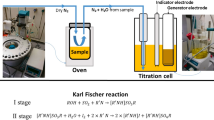Abstract
The moisture sorption isotherm is an important tool, useful for both processing and product stability applications. The saturated salt slurry method has been a standard method of generating isotherms for many years. Recently, the Vapor Sorption Analyzer (VSA) has been introduced as a new type of isotherm generating instrument and is the first instrument specifically designed to produce both equilibrium and non-equilibrium isotherms. This research compared the equilibrium isotherms generated by these two methods for five food materials and found no significant differences, demonstrating that the VSA can obtain saturated salt slurry equivalent isotherms in much less time and without visible mold growth.





Similar content being viewed by others
References
L.N. Bell, T.P. Labuza, Moisture sorption-practical aspects of isotherm measurement and use, 2nd edn. (American Association of Cereal Chemists Inc, St. Paul, MN, 2000)
S. Damodaran, K.L. Parkin, O.R. Fennema, Fennema’s food chemistry, 4th edn. (CRC Press, Boca Raton, FL, 2008), pp. 17–94
C.L. Levoguer, D.R. Williams, Application Note 101: the characterization of pharmaceutical materials by dynamic vapor sorption (Surface Management Systems, London, UK, 1997)
X. Yu, S.E. Martin, S.J. Schmidt, J. Food Sci. 73, 69–81 (2008)
M.S. Rahman, R.H. Al-Belushi, Int. J. Food Prop. 9, 421–437 (2006)
T.J. Laaksonen, Y.H. Roos, T.P. Labuza, Int. J. Food Prop. 4, 545–563 (2001)
M. Watanabe, M. Atanabe, H. Masaki, K. Takatori, J. Food Prot. 73, 1537–1542 (2010)
N. Mermelstein, J. Food Technol. 63, 64–68 (2009)
X. Yu, in Investigation of moisture sorption properties of food materials using saturated salt solution and humidity generating techniques, (Ph.D. Dissertation, University of Illinois at Urbana-Champaign, 2007)
H.M. Teoh, S.J. Schmidt, G.A. Day, J.F. Faller, J. Food Sci. 66, 434–440 (2001)
P. Arlabosse, E. Rodier, J.H. Ferrasse, S. Chavez, D. Lecomte, Drying Technol. 21, 479–497 (2003)
D.J. Burnett, F. Thielmann, J. Booth, Int. J. Pharm. 287, 123–133 (2004)
Q.E. Li, S.J. Schmidt, J. Food Sci. 76, 149–157 (2011)
S.J. Schmidt, J.W. Lee, Int. J. Food Prop. 15, 236–248 (2012)
X. Yuan, B.P. Carter, S.J. Schmidt, J. Food Sci. 76, 78–89 (2011)
B. Carter, S.J. Schmidt, J. Food Chem. 132, 1693–1698 (2012)
L.N. Bell, Drug Dev. Ind. Pharm. 21, 1649–1659 (1995)
J. Shands, T.P. Labuza, Comparison of the dynamic dewpoint isotherm method to the static and dynamic gravimetric methods for the generation of moisture sorption isotherms, (IFT annual meeting, Anaheim, CA, 2009)
W. Wolf, W.E.L. Spiess, G. Jung, in Properties of water in foods in relation to quality and stability, ed. by D. Simatos, J.L. Multon (Martinus Nijhoff, Boston, MA, 1985), pp. 661–679
E.A. Penner, in Comparison of the new Vapor Sorption Analyzer to the traditional saturated salt slurry method, (MS Thesis, University of Illinois at Urbana-Champaign, 2013)
L. Greenspan, J. Res. Natl. Bur. Stand. Sect. A Phys. Chem. 81, 89–96 (1976)
J.F. Young, J. Appl. Chem. 17, 241–245 (1967)
R.A. Lipasek, J.C. Ortiz, L.S. Taylor, L.J. Mauer, Food Res. Int. 45, 369–380 (2012)
W. Yao, X. Yu, J.W. Lee, X. Yuan, S.J. Schmidt, Int. J. Food Prop. 14, 882–893 (2011)
A.K. Salameh, L.J. Mauer, L.S. Taylor, J. Food Sci. 71, 10–16 (2006)
M. Ruegg, B. Blanc, Lebensmittel-Wissenschaft Und-Technologies 14, 1–6 (1981)
S.J. Schmidt, Manuf. Confect. 79–89 (2012)
P. Chinachoti, M.P. Steinberg, J. Food Sci. 49, 1604–1608 (1984)
S.E. Smith, J. Am. Chem. Soc. 69, 646 (1947)
P. Chinachoti, J. Food Sci. 55, 265–266 (1990)
K.W. Lang, M.P. Steinberg, J. Food Sci. 46, 1450–1452 (1981)
Acknowledgments
The authors would like to thank the FMC Corporation (Philadelphia, PA), ADM (Decatur, IL), and Tate & Lyle (Decatur, IL) for providing complementary samples for use in this research project and Daniel K. Sewell, from the Illinois Statistics Office, who assisted in the statistical data analysis.
Author information
Authors and Affiliations
Corresponding author
Rights and permissions
About this article
Cite this article
Penner, E.A., Schmidt, S.J. Comparison between moisture sorption isotherms obtained using the new Vapor Sorption Analyzer and those obtained using the standard saturated salt slurry method. Food Measure 7, 185–193 (2013). https://doi.org/10.1007/s11694-013-9154-3
Received:
Accepted:
Published:
Issue Date:
DOI: https://doi.org/10.1007/s11694-013-9154-3




